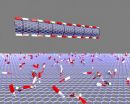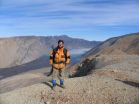(Press-News.org) A new scientific discovery could have profound implications for nanoelectronic components. Researchers from the Nano-Science Center at the Niels Bohr Institute, University of Copenhagen, in collaboration with Japanese researchers, have shown how electrons on thin tubes of graphite exhibit a unique interaction between their motion and their attached magnetic field – the so-called spin. The discovery paves the way for unprecedented control over the spin of electrons and may have a big impact on applications for spin-based nanoelectronics. The results have been published in the prestigious journal Nature Physics.
Carbon is a wonderfully versatile element. It is a basic building block in living organisms, one of the most beautiful and hardest materials in the form of diamonds and is found in pencils as graphite. Carbon also has great potential as the foundation for computers of the future as components can be produced from flat, atom thin graphite layers, observed for the first time in the laboratory in 2004 – a discovery which elicited last year's Nobel Prize in Physics.
In addition to a charge all electrons have an attached magnetic field – a so-called spin. One can imagine that all electrons carry around a little bar magnet. The electron's spin has great potential as the basis for future computer chips, but this development has been hindered by the fact that the spin has proved difficult to control and measure.
In flat graphite layers the movement of the electrons do not affect the spin and the small bar magnets point in random directions. As a result, graphite was not an obvious candidate for spin based electronics at first.
New spin in curved carbon
"However, our results show that if the graphite layer is curved into a tube with a diameter of just a few nanometers, the spin of the individual electrons are suddenly strongly influenced by the motion of the electrons. When the electrons on the nanotube are further forced to move in simple circles around the tube the result is that all the spins turn in along the direction of the tube", explain the researchers Thomas Sand Jespersen and Kasper Grove-Rasmussen at the Nano-Science Center at the Niels Bohr Institute.
It has previously been assumed that this phenomenon could only happen in special cases of a single electron on a perfect carbon nanotube, floating freely in a vacuum – a situation that is very difficult to realize in reality. Now the researchers' results show that the alignment takes place in general cases with arbitrary numbers of electrons on carbon tubes with defects and impurities, which will always be present in realistic components.
The interaction between motion and spin was measured by sending a current through a nanotube, where the number of electrons can be individually controlled. The two Danish researchers explain that they have further demonstrated how you can control the strength of the effect or even turn it off entirely by choosing the right number of electrons. This opens up a whole range of new possibilities for the control of and application of the spin.
Unique Properties
In other materials, like gold for example, the motion of the electrons also have a strong influence on the direction of the spin, but as the motion is irregular, one cannot achieve control over the spin of the electrons. Carbon distinguishes itself once again from other materials by possessing entirely unique properties – properties that may be important for future nanoelectronics.
INFORMATION:
Nature Physics: http://dx.doi.org/ + 10.1038/NPHYS1880
For more information:
Thomas Sand Jespersen, postdoc, Nanophysics, Niels Bohr Institute, University of Copenhagen,
+45 3532-0402, mobile: +45 2857-0164, tsand@fys.ku.dk
Kasper Grove-Rasmussen, postdoc, Nanophysics, Niels Bohr Institute, University of Copenhagen, +45 3532-0402, k_grove@fys.ku.dk
Curved carbon for electronics of the future
2011-01-24
ELSE PRESS RELEASES FROM THIS DATE:
Nailing down a crucial plant signaling system
2011-01-24
Stanford, CA— Plant biologists have discovered the last major element of the series of chemical signals that one class of plant hormones, called brassinosteroids, send from a protein on the surface of a plant cell to the cell's nucleus. Although many steps of the pathway were already known, new research from a team including Carnegie's Ying Sun and Zhiyong Wang fills in a missing gap about the mechanism through which brassinosteroids cause plant genes to be expressed. Their research, which will be published online by Nature Cell Biology on January 23, has implications for ...
Fighting the fight for healthy teeth
2011-01-24
It is known that teeth can protect themselves, to some extent, from attack by bacteria but that inflammation within a tooth can be damaging and, in extreme cases, lead to abscess or death of the tooth. New research published in BioMed Central's open access journal BMC Immunology shows that odontoblast cells are part of the immune system and fight to protect teeth from decay.
Inside a tooth odontoblast cells sit between the enamel and pulp and produce a layer of dentin to protect the pulp from wear and infection. This research shows that, when under attack from bacteria, ...
Genetic sequencing alone doesn't offer a true picture of human disease
2011-01-24
DURHAM, N.C. – Despite what you might have heard, genetic sequencing alone is not enough to understand human disease. Researchers at Duke University Medical Center have shown that functional tests are absolutely necessary to understand the biological relevance of the results of sequencing studies as they relate to disease, using a suite of diseases known as the ciliopathies which can cause patients to have many different traits.
"Right now the paradigm is to sequence a number of patients and see what may be there in terms of variants," said Nicholas Katsanis, Ph.D. "The ...
Researchers find smoking gun of world's biggest extinction
2011-01-24
About 250 million years about 95 per cent of life was wiped out in the sea and 70 per cent on land. Researchers at the University of Calgary believe they have discovered evidence to support massive volcanic eruptions burnt significant volumes of coal, producing ash clouds that had broad impact on global oceans.
"This could literally be the smoking gun that explains the latest Permian extinction," says Dr. Steve Grasby, adjunct professor in the University of Calgary's Department of Geoscience and research scientist at Natural Resources Canada.
Grasby and colleagues ...
More research needed on diet and environmental influences on childhood asthma
2011-01-24
St. Louis, MO, January 24, 2011 – Asthma is one of the world's most common chronic diseases, affecting as many as 300 million people. It is estimated that by 2025 there could be an additional 100 million people with the disease. This rapid increase in asthma is most likely due to changing environmental or lifestyle factors, and over the last 15 years, changing diet has emerged as a promising contributor. Two studies published in the in the February 2011 issue of the Journal of the American Dietetic Association explore the possible relationship between nutrition and asthma. ...
Anti-estrogen medication reduces risk of dying from lung cancer
2011-01-24
A new study has found that tamoxifen, an anti-estrogen breast cancer medication, may reduce an individual's risk of death from lung cancer. Published early online in Cancer, a peer-reviewed journal of the American Cancer Society, the study supports the hypothesis that there is a hormonal influence on lung cancer and that estrogen levels play a role in lung cancer patients' prognosis.
Previous research suggests that menopausal hormone therapy increases women's risk of dying from lung cancer. If this is true, the use of anti-estrogens should have the opposite effect. Elisabetta ...
IU study: Humans' critical ability to throw long distances aided by an illusion
2011-01-24
BLOOMINGTON, Ind. -- Can't help molding some snow into a ball and hurling it or tossing a stone as far into a lake as you can? New research from Indiana University and the University of Wyoming shows how humans, unlike any other species on Earth, readily learn to throw long distances. This research also suggests that this unique evolutionary trait is entangled with language development in a way critical to our very existence.
The study, appearing online Jan. 14 in the journal "Evolution and Human Behavior," suggests that the well-established size-weight illusion, where ...
Oniqua Enterprise Analytics Opens New Office in Africa
2011-01-24
Oniqua Enterprise Analytics, the leading provider of MRO analytics software solutions for asset-intensive organizations, today announced the establishment of a new office in Africa. Located in Sandton, Johannesburg, the new operations will service South Africa and the entire sub-Saharan African region.
Neil Pollock, a long-time business associate and partner of Oniqua, has been appointed Vice President and will head up the new operations.
"This expansion into Africa comes on the heels of the completion of the regional rollout of BHP Billiton's global implementation ...
New Video Resume Tool from TalentRooster Empowers Companies to See and Hear Candidates BEFORE the Interview
2011-01-24
TalentRooster (www.talentrooster.com), the world's leading video resume service today announced the release of a new record-from-home video resume tool. This new technology enables hiring managers to send a link to job candidates, providing them with an easy do-it-yourself tool to create a professional video resume from home. Hiring managers can select questions relevant to the position, which the candidate then answers in a video. There are written questions as well, should the hiring manager desire to include them.
TalentRooster CEO and President David DeCapua says ...
IIS Group, LLC Continues Growth Strategy by Acquiring Optimum Power & Environment of Florida
2011-01-24
The purchase of Optimum Power & Environment of Florida, a Manufacturer's Representative Company with a primary focus on precision mechanical and power products, was completed on August 11th 2010 in Deerfield Beach, Florida.
The strategic acquisition enables IIS Group, LLC to further its position within the blended facilities and IT channel by engaging the engineering segment and by building out data center related initiatives. Formerly located in King of Prussia, IIS Group, LLC is newly headquartered in their state-of-the art-facility in Fort Washington, PA. The move ...


